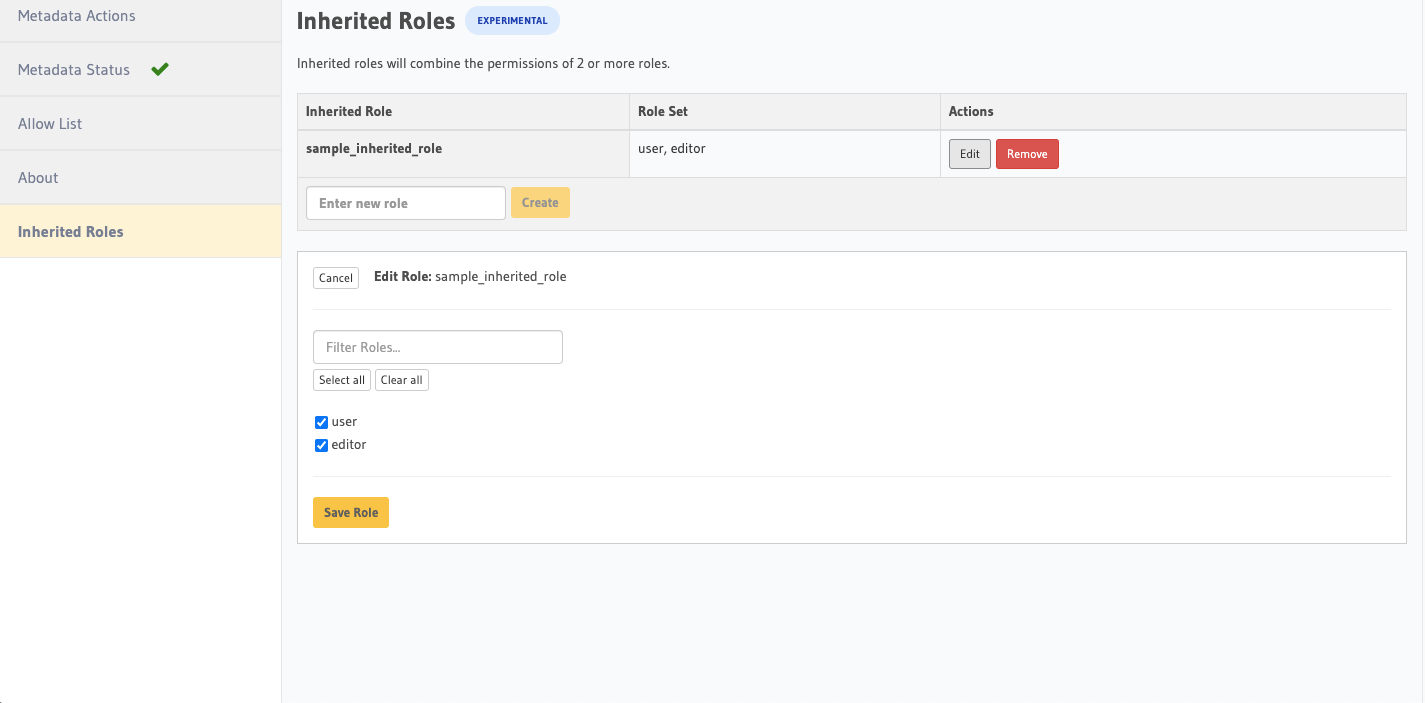Inherited roles
Introduction
An inherited role is a way to create a new role which inherits permissions from two or more roles.
Once an inherited role is created, it can be treated as any other role i.e. can be given in X-Hasura-Role session
variable.
Inherited roles are useful when you need to define multiple permission rules (may be overlapping) on schema objects and also for greater modularity in role management.
By default, inherited roles will try to inherit the permissions from its parent roles. If you'd rather like to have a different permission than the inherited one for a particular entity and role pair, then it can be done by creating a permission for the entity and role pair. After creating this permission, it will override the inherited permission, if any.
Inherited roles are supported for versions v2.0.0-alpha.4 and above. The inherited roles feature is an experimental
feature from verions v2.0.0-alpha.4 till v2.1.0-beta.1, i.e it must be explicitly toggled in order to be enabled.
This can be done either by setting the env var HASURA_GRAPHQL_EXPERIMENTAL_FEATURES or the server flag
--experimental-features to inherited_roles.
For versions v2.1.0-beta.1 and above, inherited roles are enabled by default.
Creating inherited roles
- Console
- CLI
- API
Go to the Settings tab (⚙) on the console and click on Inherited Roles.

To add a new inherited role, edit the metadata/inherited_roles.yaml file adding the inherited role definition like
this:
- role_name: sample_inherited_role
role_set:
- user
- editor
Apply the metadata by running:
hasura metadata apply
You can add a inherited role using the add_inherited_role metadata API:
POST /v1/metadata HTTP/1.1
Content-Type: application/json
X-Hasura-Role: admin
{
"type": "add_inherited_role",
"args": {
"role_name":"sample_inherited_role",
"role_set":[
"user",
"editor"
]
}
}
Inherited roles cannot form cycles.
For example:
Suppose there are two inherited roles: inherited_role1, inherited_role2 and two non-inherited roles: role1,
role2 and:
inherited_role1 inherits from role1 and inherited_role2 inherited_role2 inherits from role2 and
inherited_role1
The above configuration won't work because inherited_role1 and inherited_role2 form a cycle.
How is the permission of the inherited role inherited?
1. Select permissions
A select permission is comprised of the following things:
- Columns accessible to the role
- Row selection filter
- Limit
- Allow aggregation
- Scalar computed fields accessible to the role
Suppose there are two roles, role1 gives access to column C1 with row filter P1 and role2 gives access to
columns C1 and C2 with row filter P2. Consider the following GraphQL query executed with an inherited role
comprised of role1 and role2:
query {
T {
C1
C2
}
}
The above GraphQL query will be translated to the following SQL query.
select (case when (P1 or P2) then C1 else null end) as C1,
(case when P2 then C2 else null end) as C2
from T
where (P1 or P2)
The other parameters of the select permission will be combined in the following manner:
- Limit - Maximum of the limits will be the limit of the inherited role
- Allow aggregations - If any of the role allows aggregation, then the inherited role will allow aggregation
- Scalar computed fields - same as table column fields, as in the above example
Accessibility of a field for an inherited role
Accessibility of a field for an inherited role is defined as follows:
- When all the roles give access to a column
C, thenCwill always be accessible. - When not all, but some of the roles give access to the column
Cthen the value of the columnCwill be outputed when the OR ofP1,P2....P(n)istrueand when it evaluates tofalse, the value of the columnCwill benull, wherePis the row filter of the select permissions in which columnCis given access to. - When none of the roles give access to column
C, it won't be accessible to the inherited role.
Examples
Let's take the example of an users table with the following columns:
id- Int - Primary keyname- Textemail- Text
There are two roles defined namely employee and manager.
- User role - The user role will be able to access all columns of their row when the session variable
X-Hasura-User-Idis equal to theid. - Anonymous role - The anonymous role will be able to access only the
idandnamecolumns of all the users.
Let's create a new inherited role called user_anonymous_inherited_role which inherits from the user and the
anonymous roles.
- Executing the query as
userrole
POST /v1/graphql HTTP/1.1
Content-Type: application/json
X-Hasura-Role: user
X-Hasura-User-Id: 1
- Executing the query as
anonymousrole
POST /v1/graphql HTTP/1.1
Content-Type: application/json
X-Hasura-Role: anonymous
- Executing the query as
user_anonymous_inherited_rolerole
POST /v1/graphql HTTP/1.1
Content-Type: application/json
X-Hasura-Role: user_anonymous_inherited_role
X-Hasura-User-Id: 1
In the response of the query being executed with the user_anonymous_inherited_role role, there are 3 rows returned and
if we compare that to the queries executed as the user and anonymous roles, the results are unioned in the inherited
role. But some of the fields have null values despite the value in the database not being null. This can only happen
with inherited roles when a column doesn't have permission in the particular row. In the above example, we see that the
email of "Bob" and "Sam" is null but a non null value for "Alice", this is because the "Alice" row is executed as
the user role and the other rows are executed as the anonymous role which is why the value is null.
- Suppose we have two tables
usersandauthorsand similarly two rolesuserandauthorare defined. Theuserrole doesn't have permission to query theauthorstable and theauthorrole doesn't have permission to query theuserstable. With only theuserand theauthorrole, we won't be able to construct a query which fetches data from both the tables. This can be solved by creating an inherited role out ofuserandauthorwhich can query both the tables in a single query.
POST /v1/graphql HTTP/1.1
Content-Type: application/json
X-Hasura-Role: user_authors_inherited_role
X-Hasura-User-Id: 1
2. Mutation and Remote Schema permissions
A mutation (insert, update and delete) or remote schema permission is inherited in the following manner:
Suppose there's an inherited role (R) which inherits permissions from n parent roles namely pr1, pr2, pr3 ...
prn. The permission for the role R on some entity can only be inherited when the permission on the entity is the
same for all its parent roles.
For example, if two insert permissions are configured in the following way:
insert permission of role
pr1{
"type": "pg_create_insert_permission",
"args": {
"table": "article",
"source": "default",
"role": "pr1",
"permission": {
"check": {
"author_id": "X-HASURA-AUTHOR-ID"
}
}
}
}insert permission of the role
pr2{
"type": "pg_create_insert_permission",
"args": {
"table": "article",
"source": "default",
"role": "pr2",
"permission": {
"check": {
"author_id": "X-HASURA-USER-ID"
}
}
}
}
The check constraint is different in both the permissions and there's no way to resolve this conflict.
Whenever a conflict occurs while a role inherits from its parents, then the metadata for that entity and role
combination will be marked as inconsistent. These can be seen by calling the
get_inconsistent_metadata API.
Following the above example, the role R which is trying to inherit permissions from the role pr1 and pr2 will be
marked as inconsistent for the table permission of the table article.
This inconsistency is informational and can be ignored if the conflicting role entity pair is not going to be used. If this inconsistency needs to be resolved, then it can be done by adding a permission explicitly for the conflicting role entity pair.
3. Actions and Custom Functions permissions
Inheritance of permissions of actions and custom functions work in the following manner:
If any of the parent roles have permission configured for a given action or custom function, then the inherited role will also be able to access the given action or custom function.

